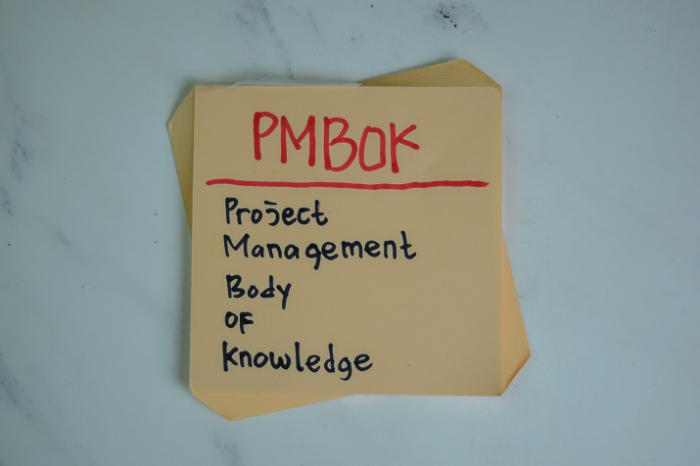
 Data Structure
Data Structure Networking
Networking RDBMS
RDBMS Operating System
Operating System Java
Java MS Excel
MS Excel iOS
iOS HTML
HTML CSS
CSS Android
Android Python
Python C Programming
C Programming C++
C++ C#
C# MongoDB
MongoDB MySQL
MySQL Javascript
Javascript PHP
PHP
- Selected Reading
- UPSC IAS Exams Notes
- Developer's Best Practices
- Questions and Answers
- Effective Resume Writing
- HR Interview Questions
- Computer Glossary
- Who is Who
Differences between PMBOK 6 and PMBOK 7
A successful project management program is a vital component of any organization's success. Whether it's in the field of construction or business operations, project managers have the necessary skills and knowledge to effectively carry out their duties.
Due to the increasing number of professionals in the project management industry, many people are considering pursuing a Post Graduate Program in project management.
If you're planning on taking the Project Management Institute's (PMI) certification exam in 2021, you'll be in for a major change in the way the exam is conducted. The new version of the exam, known as PMBOK 7, features more detailed coverage of the requirements.
Since 1996, the PMBOK has been providing the necessary resources for aspiring project managers to successfully take the certification exam.

What is PMBOK 6?
PMBOK 6 provides a comprehensive overview of the various roles and responsibilities of a project manager. It also covers the key knowledge areas that project managers need to know. It contains 10 knowledge areas that are focused on project management. These areas are broken down into processes, tools, techniques, and outputs.
The PMBOK 6 provides a schedule that allows project managers to complete the project in a timely manner. The cost is also managed through the estimating and allocating of all related expenses. It also provides a variety of tools and resources that help project managers improve their efficiency. These include planning and scheduling the resources needed for the project.
What is PMBOK 7?
The PMBOK 7 contains models, artifacts, methods, and tailoring, as well as eight performance domains. The changes to processes and the transformations to performance are dramatic. The performance domains are designed to measure the overall outcomes of a project, not just the techniques and processes used in its execution. They also emphasize the importance of project quality.
The latest version of PMBOK features performance domains instead of knowledge areas. This eliminates the need for traditional knowledge areas. The eight performance domains of PMBOK are designed to provide a comprehensive view of the various elements that contribute to a project's success. They include the team, stakeholder groups, planning, project work, and unpredictability and ambiguity. The eight performance domains of PMBOK are designed to help organizations deliver value to their stakeholders.
PMBOK 6 Vs PMBOK 7
| Key Areas | PMBOK 6 | PMBOK 7 |
|---|---|---|
| Overall Approach | The overall approach in the PMBOK Guide ? 6th edition is more biased towards prescriptive and not descriptive, i.e. the emphasis is on how, not on what or why. | The PMBOK Guide ? 7th edition contains principles to guide mindsets, actions, and behaviors, which are reflected in the bodies of knowledge for project delivery, agile, lean, customer-centered design, and more. |
| Basis for Design | In PMBOK Guide ? 6th edition, the specific processes convert inputs to outputs, using tools and techniques. It is more process-focused and orientation is compliance driven. | In PMBOK Guide ? 7th edition, the domains of interactive, independent areas of activity are with performance outcomes as well as an overview of commonly used tools, techniques, artifacts, and frameworks. Also, the focus is on project outcomes along with the deliverables. |
| Project Environment | In PMBOK Guide ? 6th edition, the project environment comprises both internal and external factors. | In PMBOK Guide ? 7th edition, the project environment comprises both internal and external factors. |
| Project Application | The PMBOK Guide ? 6th edition can be used as a project application guide for most of the projects, most of the time. | The PMBOK Guide ? 7th edition can be used as a project application guide for any of the projects, anytime. |
| Target Audience | The PMBOK Guide ? 6th edition has a target audience usually comprising Project Managers. | The PMBOK Guide ? 7th edition has a target audience usually comprising anyone in the project with a specific focus on team members and team roles, including persons with title of project lead, project sponsor, and project owner. |
| Degree of Change | In PMBOK Guide ? 6th edition, the degree of change is determined by incremental revisions based on previous editions. | In PMBOK Guide ? 7th edition, the degree of change is principle-based in order to reflect the full-value delivery landscape. |
| Tailoring Guidance | In PMBOK Guide ? 6th edition, there are some references to tailoring, but no specific guidance can be found. | In PMBOK Guide ? 7th edition, specific tailoring guidance can be found. |
Benefits of Using PMBOK 7 as a Course Training Foundation
The PMBOK 7 framework can help organizations achieve their goals and objectives. This is why it is important that organizations thoroughly study it. The success of a company depends on the timely completion of its projects. This is why it is important that your employees have the necessary skills and knowledge to manage projects. This is why it is important that they are certified through the Project Management Professional (PMP) certification.
Having the necessary skills and knowledge to manage projects ensures that employees can communicate effectively with each other. Most of the time, a project manager's time is spent talking to team members and sponsors. Having the necessary skills and knowledge to speak a common language allows them to easily communicate with other people.
The ability to manage projects in a repeatable and structured manner provides professionals with the necessary tools and procedures to carry out their duties. This is because the procedures used in project management can be applied to various issues.
Projects can fail due to various factors, such as the lack of resources, an unrealistic schedule, and financial concerns. With the right training, managers can confidently manage projects and deliver successful results. Having the necessary skills and knowledge to carry out their duties can help minimize errors and improve the quality of the project.
By having the right training, managers can improve the work culture of their subordinates. Having the necessary skills and knowledge to manage projects can help minimize errors and improve the quality of the project. The way the manager handles projects can serve as an example for other team members.
Having the right training is also beneficial for a company as it allows employees to confidently carry out their duties. Having the necessary skills and knowledge to manage projects can help ensure that the projects are completed on time and on budget.
Conclusion
The seventh edition of the PMBOK Guide introduces new features and procedures, such as performance domains, models, artifacts, and methods. The sixth edition brought some process changes. The seventh edition is an update to the project management discipline's overall structure. It should be noted that project managers should pick the seventh edition over the sixth edition if they want to keep up with the changes.

